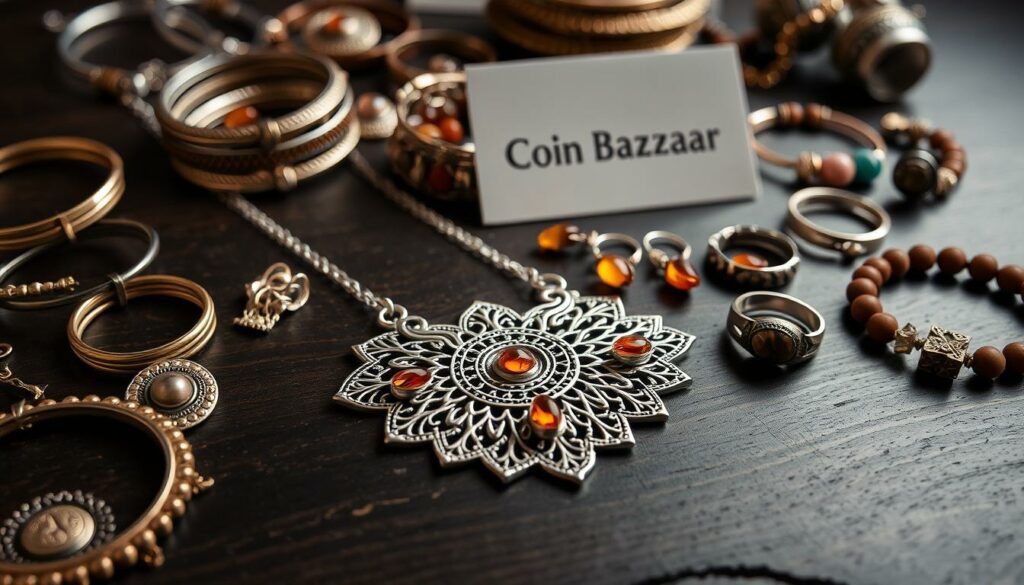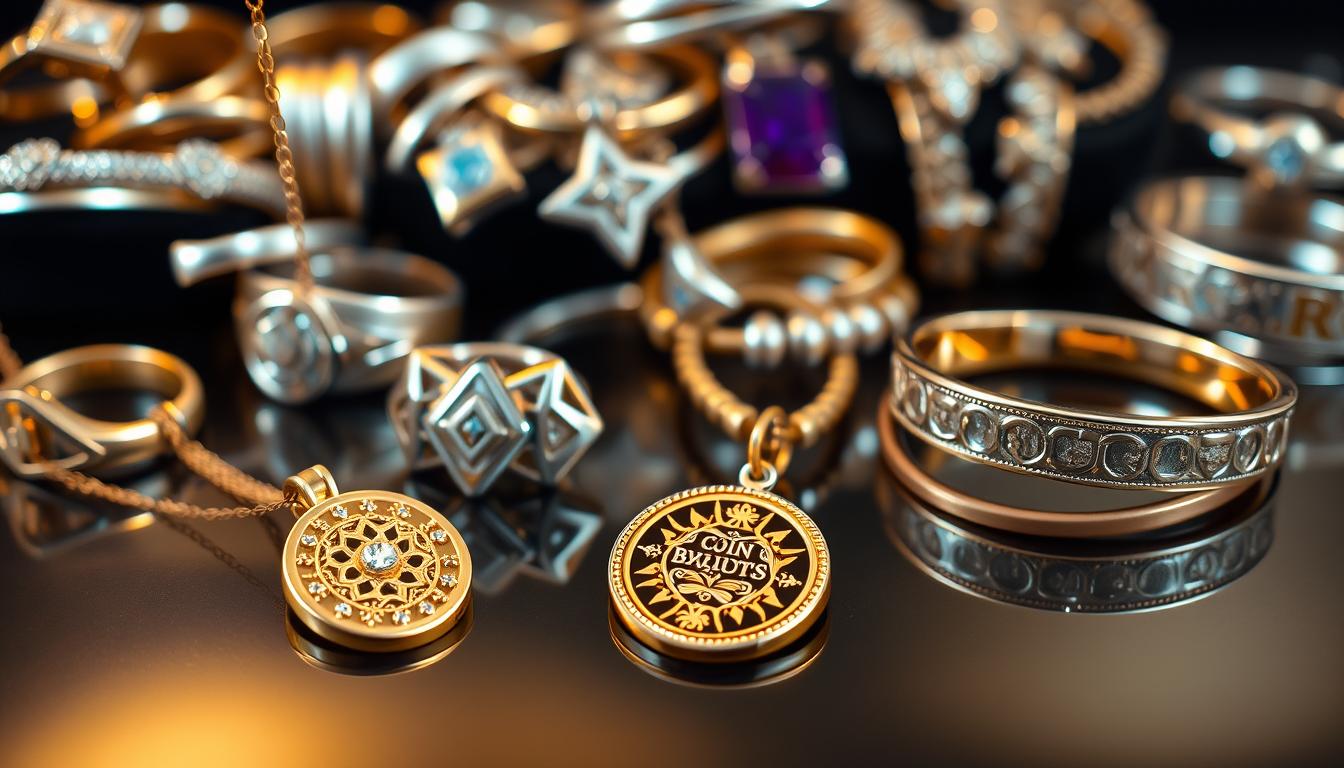You might know how appealing personalized jewelry can be. The global handmade jewelry market was worth $151.5 billion in 2022. It’s expected to hit $472.5 billion by 2032. This shows people love unique, made-to-order items.
Tier II markets are leading this trend. People want more than just common items. They seek pieces that show off their individuality. This makes custom jewelry very appealing. So, businesses are now focusing on creating these special items.
Key Takeaways
- The global handmade jewelry market is growing at a CAGR of 11.9%.
- Tier II markets are driving the demand for customized jewelry.
- Consumers are seeking unique, personalized pieces.
- Custom jewelry is becoming increasingly profitable.
- Businesses are adapting to cater to the growing demand for personalized jewelry.
The Evolving Jewelry Landscape in Tier II Indian Markets
The jewelry market in Tier II Indian cities is changing fast. This is due to new tastes and tech progress. Now, both fashion jewelry and fine jewelry are in high demand.


Current Market Size and Growth Projections
India’s gems and jewelry market hit USD 100.94 billion in 2024. It’s set to hit USD 168.62 billion by 2030, growing 8.93% yearly. This growth is not just in big cities; Tier II cities are playing a big role too.
The demand for fashion jewelry is especially high in these areas. This is because it’s affordable and versatile.
Changing Consumer Preferences in Smaller Cities
People in Tier II cities now want unique and personal jewelry. They’re also looking at fine jewelry more, thanks to higher incomes and a wish to buy quality. Online shopping and social media have made it easier for them to find and buy jewelry.
Some key trends include:
- More people want custom jewelry
- Online jewelry shopping is getting popular
- Fashion jewelry is in demand during festivals and special times
- There’s a growing love for traditional craftsmanship in fine jewelry
As the market in Tier II cities keeps changing, knowing what consumers want is key. This is important for businesses aiming to meet the growing need for both fashion jewelry and fine jewelry.
Understanding Custom Jewelry: Definition and Appeal
Personalized jewelry is becoming more popular. People want unique, meaningful items that show their style. Custom jewelry offers a personal touch that mass-produced items can’t match.
Exploring custom jewelry reveals it’s about more than uniqueness. It’s about creating something with emotional value. Handmade jewelry especially offers a personal touch that many find appealing.
What Constitutes Truly Custom Jewelry
True custom jewelry is made from scratch, based on your ideas. You work closely with the jeweler to make your vision real. This results in a piece that truly reflects your style.
Custom jewelry stands out because of:
- Unique designs that fit your taste
- High-quality craftsmanship
- Use of premium materials
- Direct interaction with the jeweler


The Emotional Value Proposition of Personalized Pieces
Custom jewelry holds emotional value. It can tell a story or mark a special moment. Whether it’s a custom engagement ring or a personalized necklace, these items are treasured.
| Emotional Value Drivers | Description | Example |
|---|---|---|
| Personal Significance | Pieces that hold personal meaning or symbolism | Custom engagement ring with special birthstone |
| Unique Storytelling | Jewelry that tells a story or commemorates an event | Personalized necklace with engraved message |
| Emotional Connection | Items that evoke emotions or create new memories | Bespoke anniversary gift with special date engraved |
When thinking about custom jewelry, remember its value goes beyond money. The emotional connection and personal significance make these pieces truly special.
Mass-Produced Jewelry: Advantages and Limitations
Mass-produced jewelry is popular because it’s affordable and good quality. It’s something many people can buy. You might like it for different reasons.
Production Efficiency and Economies of Scale
One big plus of mass-produced jewelry is how fast and cheap it is to make. Companies can make lots of pieces quickly and at a lower cost. This means they can sell them for less money.
Buying mass-produced jewelry can save you money. It’s also good for businesses because they can keep up with trends fast.
Standardization vs. Uniqueness Tradeoffs
But, there are downsides to mass-produced jewelry. It’s often the same everywhere, lacking in uniqueness. This might not be what you want if you’re looking for something special.
Still, many people like the reliability and quality of mass-produced jewelry. It’s consistent and well-made. As a business, you have to think about what’s more important: being unique or saving money.
In summary, mass-produced jewelry is a mix of affordability and style. It’s made efficiently and in large numbers. Even though it’s not as unique as custom pieces, it’s a big part of the jewelry world.
The Business Model Comparison: Custom vs. Mass Production
When you look into the jewelry market, you’ll see two main types: custom and mass-produced. Each has its own needs and goals. Your choice depends on what you want to achieve, who you want to sell to, and what you have to start with.
Experts say, “Success in jewelry comes from knowing your market and picking the right model for them.” Let’s dive into the costs and how these businesses work differently.
Initial Investment Requirements for Both Approaches
Starting a custom jewelry business might cost more. You’ll need talented artists and design tools. This includes software, top-notch materials, and training for your team. Mass-produced jewelry, however, needs a big investment in machines and stock.
For example, a custom fine jewelry business might spend $100,000 on design and making. A mass-produced fashion jewelry business could need $500,000 for a factory setup. Knowing these costs is key to a solid business plan.
Operational Differences and Staffing Needs
Custom jewelry needs skilled artists and designers for unique pieces. This model is all about quality and detail. Mass-produced jewelry, however, aims for speed and big numbers, often using machines.
Staffing is different too. Custom jewelry needs people with special skills. Mass production looks for those who can handle big jobs and keep quality up. Experts say, “The right team is vital, no matter your model.”
In short, knowing the differences between custom and mass-produced jewelry is crucial. By looking at costs and how they work, you can pick the best fit for your business.
Cost Analysis: Breaking Down the Numbers
Knowing the financial side of jewelry making is key for businesses wanting to make more money. As you explore the jewelry market, a detailed cost analysis is vital. It helps you make smart choices about how you make your jewelry.
Material Costs and Sourcing Considerations in India
Material costs are a big part of making jewelry. In India, buying materials locally can cut costs. Think about the quality and availability of materials like gold, silver, and precious stones when picking suppliers.
Gold is a favorite for jewelry in India. Getting it from trusted suppliers ensures quality. Gold prices can change, so keeping up with market prices is important.
Labor and Production Expenses
Labor costs are also very important. Skilled workers are needed for detailed designs, especially for custom pieces. Finding the right balance between labor costs and quality is crucial.
Production costs also include the cost of tools and technology. Investing in new tech can make your process more efficient and save money in the long run.
Overhead and Marketing Expenditures
Overhead costs, like rent and utilities, add up. Good marketing is also key to draw in customers. Set aside a budget for marketing, including online ads and events.
| Cost Component | Custom Jewelry | Mass-Produced Jewelry |
|---|---|---|
| Material Costs | Variable, based on design | Standardized, often lower due to bulk purchasing |
| Labor Expenses | Higher due to skilled craftsmanship | Lower due to mechanized production |
| Overhead Expenditures | May require more space for design and storage | Often lower due to larger production volumes |
| Marketing Expenditures | Targeted marketing for unique pieces | Broader marketing strategies for mass appeal |
By understanding and managing these costs, you can make your jewelry business more profitable. Whether you focus on custom or mass-produced jewelry, a detailed cost analysis is essential for smart business decisions.
Pricing Strategies for Maximum Profitability
Setting the right price is key for jewelry businesses aiming to make more money in competitive markets. You must find a balance. This means pricing your items, like necklaces and bracelets, so they’re competitive yet still profitable.
Value-Based Pricing for Custom Jewelry
Custom jewelry pricing is all about the unique value and craftsmanship. When pricing fine jewelry made just for someone, think about the design’s complexity, material costs, and how much it means to the buyer. For example, a custom engagement ring might cost more because of its special meaning and the skill needed to make it.
| Factor | Impact on Pricing |
|---|---|
| Design Complexity | Increases price due to expertise required |
| Material Costs | Directly affects pricing based on material value |
| Emotional Value | Can significantly increase perceived value |
Competitive Pricing in Mass-Produced Markets
For mass-produced jewelry, the focus is on keeping prices competitive. You need to look at what others are charging for similar items, like necklaces and earrings. It’s important to stay competitive but also make sure your prices cover costs and give you the profit you want.
Understanding both value-based and competitive pricing helps you set prices that boost your profits in the jewelry market.
Jewelry Profit Margin Analysis by Category
Different jewelry types have unique profit margins. These are shaped by material costs, demand, and how complex they are to make. Knowing these differences is key for business owners to boost profits in Tier II markets.
Rings and Engagement Jewelry
Rings, especially engagement rings, have high profit margins. This is because they hold emotional value and come with a higher price tag. The use of precious metals and stones also adds to their cost.
For example, a custom-designed engagement ring with a top-notch diamond can have a big markup.
Necklaces and Pendants
Necklaces and pendants offer a range of profit margins. They can be from affordable fashion items to expensive, detailed designs. The profit margin changes based on the material, with gold and silver being pricier than base metals.
Earrings and Bracelets
Earrings and bracelets have different profit margins. Earrings, being simpler to make, can have high margins if they’re made from precious materials. Bracelets, especially those with intricate designs or made from precious materials, can also bring in good profits.
Fashion vs. Fine Jewelry Considerations
Fashion and fine jewelry have different profit margins. Fine jewelry, with its precious metals and gemstones, usually has higher margins. Fashion jewelry, made from cheaper materials, has lower margins but can be sold in larger quantities.
The Tier II Market Advantage: Why Location Matters
For jewelry businesses, Tier II markets offer a big advantage. They are more appealing than big cities because of their special mix of chances and hurdles.
Reduced Competition and Operating Costs
One key benefit of Tier II markets is the reduced competition. Unlike big cities, these areas have fewer established jewelry brands. This makes it easier for your business to stand out. Plus, the costs of running a business here are lower. You can save money on rent and labor, which helps you use your resources better.
Building Strong Community Relationships
Building strong ties with the local community is key in Tier II markets. You can get to know your customers better and make products they love. This personal connection can make your customers loyal and spread the word about your business.
Cultural Factors Influencing Jewelry Purchases
Cultural factors are very important in jewelry buying in Indian Tier II cities. Knowing these cultural details helps you make and market your products better. For example, certain jewelry is popular during festivals. By understanding these cultural tastes, you can make products that your customers will love, boosting your sales and happiness.
In summary, Tier II markets are great for jewelry businesses. They offer less competition, lower costs, and a chance to connect deeply with the community. This makes them a perfect place to grow or start a jewelry business.
Customer Acquisition and Retention Strategies
If you own a jewelry business in India’s Tier II markets, you’re always looking for ways to keep customers coming back. It’s key to have good strategies for getting and keeping customers. This is vital for your business to grow over time.
You can use many ways to attract and keep customers, like digital marketing, loyalty programs, and making the most of festivals and wedding seasons.
Digital Marketing Approaches for Jewelry Businesses
Digital marketing is a strong tool for finding new customers and showing off your personalized jewelry and handmade jewelry. Here are some ways to use it:
- Use social media like Instagram and Facebook to post beautiful pictures of your jewelry.
- Work with influencers to reach more people.
- Send out emails to keep your customers updated on new items and deals.
Creating Loyalty Programs That Work
Loyalty programs can keep customers coming back by rewarding them for buying again. Think about offering:
- Points for every purchase.
- Special discounts for loyal customers.
- Early access to new and limited items.
Leveraging Festivals and Wedding Seasons in India
India’s festivals and wedding times are big chances for jewelry businesses. You can:
- Make special collections for festivals like Diwali and Navratri.
- Offer wedding jewelry packages with customized and handmade pieces.
- Host events and promotions during the busiest wedding times.
By using these strategies, you can get and keep more customers. This will help your jewelry business grow in India’s Tier II markets.
Technology Integration in Modern Jewelry Businesses
Modern jewelry businesses are using technology to make things better for customers and to work more efficiently. This change is affecting many parts of the industry, like design, making, selling, and talking to customers.
Design Software and Production Tools
Advanced design software and production tools are changing how jewelry is made. Computer-Aided Design (CAD) software lets designers make precise and detailed designs. 3D printing makes it fast to make prototypes and products.
For example, CAD software can help make detailed designs for fashion jewelry, like fancy earrings designs. These designs can then be made using 3D printing or traditional methods.
E-commerce and Social Media Platforms
E-commerce and social media have changed how jewelry businesses talk to customers. Online stores let jewelers show their products to people all over the world. Social media helps them share their story, connect with customers, and build a community.
To do well, businesses need to make interesting content, work with influencers, and use ads to find new customers.
Virtual Try-On and Augmented Reality Applications
Virtual try-on and augmented reality (AR) apps are making online shopping better. These apps let customers see how jewelry looks on them without trying it on. This makes customers happier and helps reduce returns.
A jewelry expert said, “The future of jewelry retail is about giving customers amazing experiences. AR technology is leading this change.”
Case Studies: Successful Jewelry Business Models in Tier II Cities
Looking into successful jewelry businesses in Tier II cities shows us smart strategies. These cities, though smaller, offer great chances for jewelry shops to grow. They do this by meeting local tastes and needs.
Learning from businesses that have done well in these markets is key. We’ll look at examples of both custom and mass-produced jewelry success.
Custom Jewelry Success Stories from Indian Markets
Custom jewelry shops have done great in Tier II cities. They make unique pieces that locals love. For example, a small city might specialize in detailed necklaces made just for the customer.
One success story is a custom jewelry store that used social media well. It showed off its designs, getting more customers and sales. The store’s quick and personal service kept customers coming back.
Mass-Production Success Stories and Lessons Learned
Mass-produced jewelry has also done well in Tier II cities. These shops offer many items at good prices. They use big orders and efficient supply chains to save money.
A jewelry brand is a great example. It set up shops in several Tier II cities with a wide range of jewelry. Keeping the same quality and look everywhere helped it grow a loyal customer base.
Both custom and mass-produced jewelry businesses teach us important lessons. By knowing what locals want and picking the right model, you can start a successful jewelry business in Tier II cities.
Hybrid Approaches: Combining Custom and Mass-Production Elements
Jewelry businesses are now mixing custom designs with mass production. This way, they can offer a variety of products. From unique, personalized items to more affordable, mass-produced ones.
Semi-Custom Options and Customizable Templates
Semi-custom jewelry is a mix between custom and mass-produced. It lets customers personalize some parts, like engravings or gemstones. This keeps production efficient. It’s great for rings and bracelets, where people want something special but also reliable.
Balancing Efficiency with Personalization
For a hybrid approach to work, you need to balance efficiency with personalization. Use flexible manufacturing technologies and train your team well. This way, you can serve a wide range of customers. From those looking for affordable jewelry to those willing to pay for custom pieces.
Inventory Management for Hybrid Jewelry Businesses
Good inventory management is essential for hybrid jewelry businesses. You must have enough mass-produced items and be ready to make custom pieces fast. An inventory management system that tracks both can help. It makes your operations better and keeps customers happy.
Conclusion: Making the Right Choice for Your Jewelry Business
Choosing the right business model for your jewelry venture depends on several factors. These include your target market, resources, and what your customers like. Custom and mass-produced jewelry each have their own pros and cons.
Knowing your target market is key to picking the most profitable model. If your customers want unique pieces and are willing to pay more, custom jewelry might be best. But, if you aim for a bigger market with more affordable options, mass-produced jewelry could be better.
To succeed in the Indian Tier II markets, think about your resources, what your customers want, and the competition. By making a smart choice, you can build a successful jewelry business. This business will meet your customers’ needs and help you grow in the long run.














